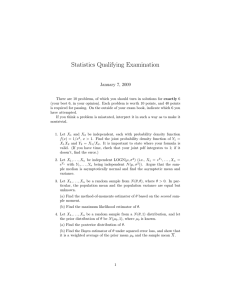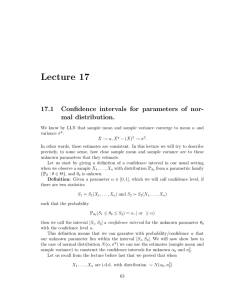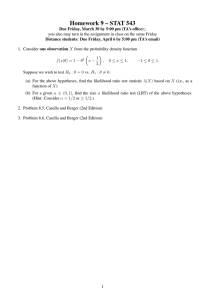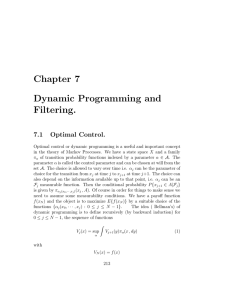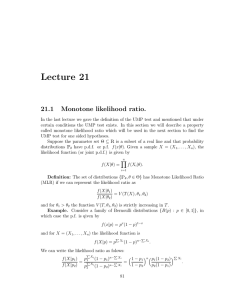Lecture 22 22.1 One sided hypotheses continued.
advertisement
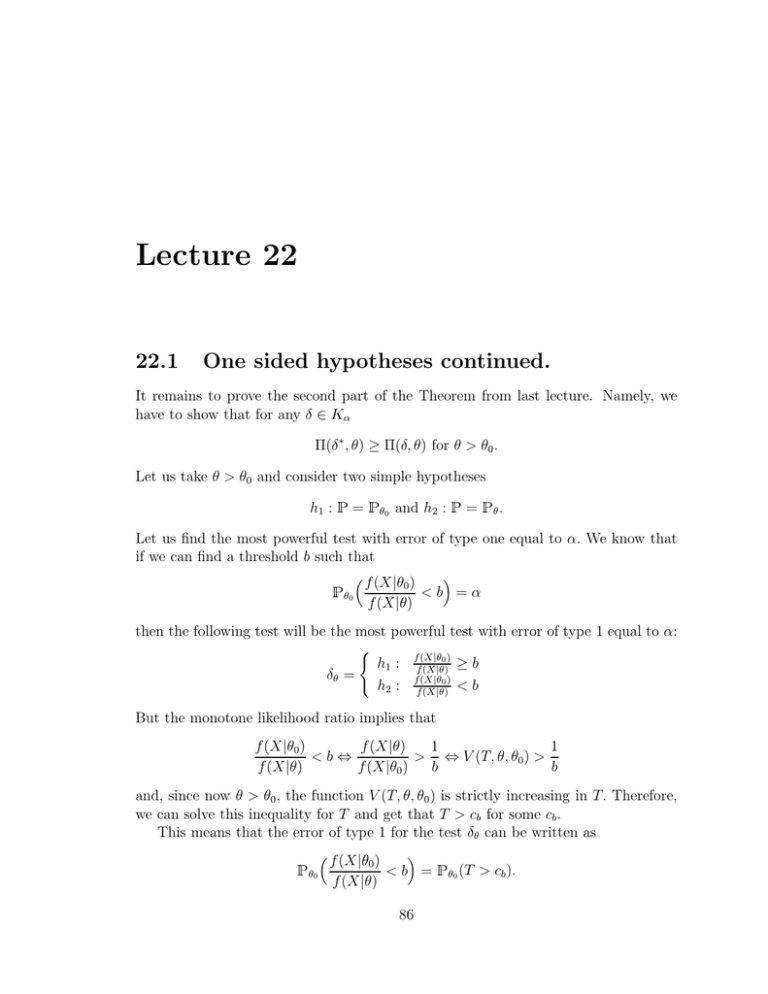
Lecture 22 22.1 One sided hypotheses continued. It remains to prove the second part of the Theorem from last lecture. Namely, we have to show that for any δ ∈ Kα Π(δ ∗ , θ) ≥ Π(δ, θ) for θ > θ0 . Let us take θ > θ0 and consider two simple hypotheses h1 : = θ0 and h2 : = θ. Let us find the most powerful test with error of type one equal to α. We know that if we can find a threshold b such that f (X|θ ) 0 <b =α θ0 f (X|θ) then the following test will be the most powerful test with error of type 1 equal to α: ( 0) h1 : ff(X|θ ≥b (X|θ) δθ = f (X|θ0 ) h2 : f (X|θ) < b But the monotone likelihood ratio implies that f (X|θ0 ) f (X|θ) 1 1 <b⇔ > ⇔ V (T, θ, θ0 ) > f (X|θ) f (X|θ0 ) b b and, since now θ > θ0 , the function V (T, θ, θ0 ) is strictly increasing in T. Therefore, we can solve this inequality for T and get that T > cb for some cb . This means that the error of type 1 for the test δθ can be written as f (X|θ ) 0 < b = θ0 (T > cb ). θ0 f (X|θ) 86 87 LECTURE 22. But we chose this error to be equal to α = θ0 (T > c) which means that cb should be such that θ0 (T > cb ) = θ0 (T > c) ⇒ c = cb . Therefore,we proved that the test δθ = h1 : T ≤ c h2 : T > c is the most powerful test with error of type 1 equal to α. But this test δθ is exactly the same as δ ∗ and it does not depend on θ. This means that deciding between two simple hypotheses θ0 vs. θ one should always use the same most powerful decision rule δ ∗ . But this means that δ ∗ is uniformly most powerful test - what we wanted to prove. Notice that MLR played a key role here because thanks to MLR the decision rule δθ was independent of θ. If δθ was different for different θ this would mean that there is no UMP for composite hypotheses because it would be advantageous to use different decision rules for different θ. Example. Let us consider a family of normal distributions N (µ, 1) with unknown mean µ as a parameter. Given some µ0 consider one sided hypotheses H1 : µ ≤ µ0 and H2 : µ > µ0 . As we have shown Pn before the normal family N (µ, 1) has monotone likelihood ratio with T (X) = i=1 Xi . Therefore, the uniformly most powerful test with level of significance α will be as follows: P H1 : Pni=1 Xi ≤ c ∗ δ = n H2 : i=1 Xi > c. The threshold c is determined by α= µ0 (T > c) = µ0 ( X Xi > c). If the sample comes from N (µ0 , 1) then T has distribution N (nµ0 , n) and n 1 X Y =√ (Xi − µ0 ) ∼ N (0, 1) n i=1 is standard normal. Therefore, α= µ0 ( n X i=1 Xi > c) = µ0 n c − nµ0 1 X (Xi − µ0 ) > √ . Y =√ n i=1 n 88 LECTURE 22. Therefore, if using the table of standard normal distribution we find cα such that (Y > cα ) = α then √ c − nµ0 √ = cα or c = µ0 n + ncα . n Example. Let us now consider a family of normal distributions N (0, σ 2 ) with variance σ 2 as unknown parameter. Given σ02 we consider one sided hypotheses H1 : σ 2 ≤ σ02 and H2 : σ 2 > σ02 . Let us first check if MLR holds in this case. The likelihood ratio is Pn Pn 2. 2 − 12 − 12 1 f (X|σ22 ) 1 i=1 Xi i=1 Xi 2σ2 2σ1 √ √ = e e f (X|σ12 ) ( 2πσ2 )n ( 2πσ1 )n P 2 σ n σ n 1 1 1 1 T − − X 2 2 2 2 i 1 1 e 2σ1 2σ2 e 2σ1 2σ2 , = = σ2 σ2 Pn 2 2 2 where T = i=1 Xi . When σ2 > σ1 the likelihood ratio is increasing in T and, therefore, MLR holds. By the above Theorem, the UMP test exists and is given by P H1 : T = Pni=1 Xi2 ≤ c ∗ δ = H2 : T = ni=1 Xi2 > c where the threshold c is determined by α= σ02 ( n X Xi2 > c) = i=1 σ02 n X X 2 i i=1 σ0 > c . σ02 When Xi ∼ N (o, σ02 ), Xi /σ0 ∼ N (0, 1) are standard normal and, therefore, n X Xi 2 i=1 σ0 ∼ χ2n has χ2n distribution with n degrees of freedom. If we find cα such that χ2n (cα , ∞) = α then c = cα σ02 .
